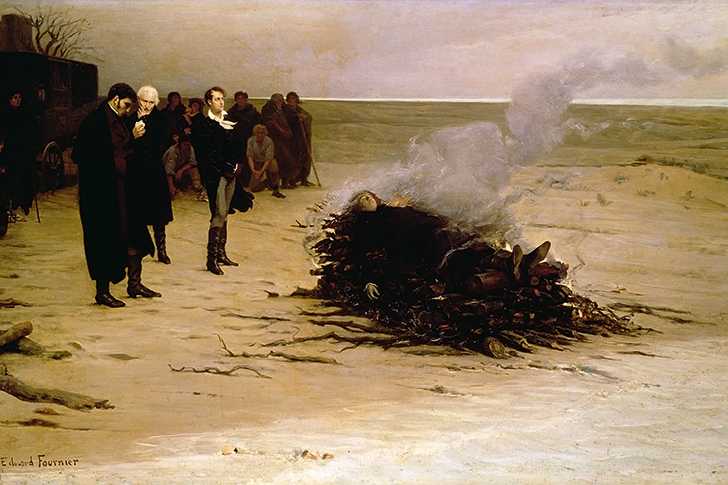In Deaths of the Poets two living examples of the species, Paul Farley and Michael Symmons Roberts, retail the closing moments of close on 30 poetical lives, ranging from Thomas Chatterton to Robert Frost, Lord Byron to Rosemary Tonks, John Clare to Thom Gunn. Why? Because they feel the influence on ‘our’ generation (Farley was born in 1965 and Symmons Roberts in 1963) of the ‘confessional’ American poets, several of whom cast a solemn glamour over their calling by killing themselves — John
Berryman, Sylvia Plath, Anne Sexton. Because they think that a shrinking appetite for poetry itself, and an unflagging curiosity about the most dramatic elements in poet’s biographies (of which death must count as one), is bound to turn the end of a life into a ‘lens’ through which we view everything that came before it. And because they suppose that there’s an ‘association between poets and mortality’, since a lot of people think if poets are any good they must be ‘doomed’ — not to mention melancholy, drunken, lascivious and incapable of tying their own shoelaces.
All these notions have their interest, but it has to be said they don’t inevitably shed much light on anyone’s work. And as Farley and Symmons Roberts also say, it’s perfectly easy to create an alternative image of the poetic past, by listing all the long-lived and lucid poets who, however they might have experienced difficulties and feared death, insisted on clinging to life and reason. Larkin made the point memorably, as Farley and Symmons Roberts allow: ‘Chaucer, Wordsworth, Hardy,’ he said, ‘it’s the big, sane boys who get the medals. The object of writing is to show life as it is, and if you don’t see it like that you’re in trouble, not life.’
To put all this another way: Deaths of the Poets is no less interesting as an idea than a book on poets and some other aspect of their existence — childhood, say. But while Farley and Symmons are good at telling (pretty familiar) stories, they’re hampered by the weakness of their founding arguments, and by their reluctance to follow up on them.
To take one instance among many: after quoting an excellent remark that Nadine Gordimer made to Christopher Hitchens —‘ a serious person should try to write posthumously’ — they miss the chance to discuss how writers’ sense of mortality might provoke them to devise ways of taking aim at eternity over the heads of the present. In a book more deeply concerned with poetry itself, this might have led them in turn to discuss the whole notion of how poets treat ‘contemporary subjects’ in their work. And then to consider ideas about the death of the author that we associate with Roland Barthes. And then to explore the sense of lateness and transcendence that lie at the foundations of most people’s impulse to write.
That said, Farley and Symmons Roberts are generous with simpler pleasures. They deal with an impressively large number of cases; they are generally clever at making their two voices sound like one (except when they’re talking about religion, and a rather singular-sounding academic note emerges), and they are determined not to write gloomily about a gloomy subject. So determined, indeed, that the tone of the book in fact becomes a bit of a problem. Its style is generally so breezy (‘conned’, ‘fingered’, ‘nails it’), the catch-phrases so determinedly catchy (‘death is the big line break’, Robert Lowell is ‘the Daddy of the Confessionals’), it’s difficult not to think that the boys should stop wisecracking so much, since thinking properly about their subject means something like being in church.
Should stop making a fuss, too, since in a book that inevitably involves a lot of travel and research, they routinely make heavy weather of both. They’re so overcome when they reach the house where Anne Sexton killed herself, they don’t even get out of the car. When they look through Gunn’s archive they feel ‘squeamish’. Elsewhere, they’re variously slapping on the Factor 40 as they head round New York in the heat, feeling sick as they fly over the Great Lakes, running through ‘nervous checks’ of passports and wallets, and in a ‘panic over whether we’ve enough euros to cover our meal’.
The aim throughout seems to have been to lighten the weight of what might
otherwise have been an oppressively heavy subject by adopting a tone of self-mocking jauntiness — a decision which perhaps was influenced by Paul Farley’s experience in working for radio (he very successfully presents the excellent Echo Chamber on Radio 4), where such a style can work well. On the page, when not handled with Geoff Dyer-like dexterity, it risks sounding simply flip. Furthermore, it wrings most of the value from other voices included along the way: the poets Daisy Fried, Jo Shapcott and Sean O’Brien are some of several who are engaged as temporary companions, and none of them says anything that looks significant on the page.
As a late riposte to Dr Johnson’s Lives, Deaths of the Poets has the combined merit of being energetic yet affable. But its effect is limited by its preoccupation with final scenes, rather than with the question of how finality itself has been imagined, anticipated, dreaded or even welcomed in the work leading up to it.






Comments